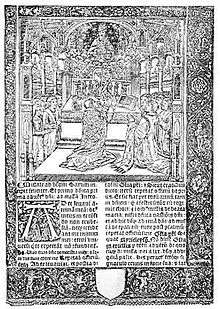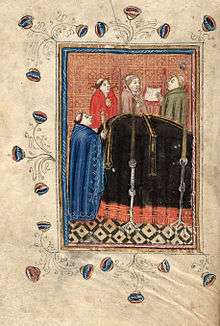Sarum Rite
The Sarum Rite, more properly called the Use of Salisbury, was a variant ("use") of the Roman Rite widely used for the ordering of Christian public worship, including the Mass and the Divine Office. It was established by Saint Osmund, Bishop of Salisbury,[1] and Richard Poore in the 11th century and was originally the local form used in the Cathedral and Diocese of Salisbury, England.
It later became prevalent throughout southern England and came to be used throughout most of England, Wales, Ireland, and (later) Scotland, until the reign of Queen Mary I and King Philip.[2] Although abandoned after the 16th century and the Protestant Reformation, it was a notable influence on the pattern of Anglican liturgy represented in the Book of Common Prayer. Occasional interest in and attempts at restoration of the liturgy by Anglicans and Catholics have not, however, produced a general revival.
History

In 1078, William of Normandy appointed Osmund, a Norman nobleman, as bishop of Salisbury (the period name of the site whose ruins are now known as Old Sarum). As bishop, Osmund initiated some revisions to the extant Celtic-Anglo-Saxon rite and the local adaptations of the Roman rite, drawing on both Norman and Anglo-Saxon traditions.
19th-century liturgists theorized that the liturgical practices of Rouen in northern France inspired the Sarum liturgical books. The Normans had deposed most of the Anglo-Saxon episcopate, replacing them with Norman bishops, of which Osmund was one. Given the similarities between the liturgy in Rouen and that of Sarum, it appears the Normans imported their French liturgical books as well.[3]
This conjecture approaches certainty when it is found that the Use of Rouen and that of Sarum were almost identical in the 11th century. A curious and interesting illustration of this will be found in an extract of a Rouen manuscript missal, assumed to be 650 years old ... . The Rouen Pontifical, of about 1007 A.D., quoted in the same work, shows a like affinity of that of Sarum and Exeter in later days.[3]
The revisions during Osmund's episcopate resulted in the compilation of a new missal, breviary, and other liturgical manuals, which came to be used throughout southern England, Wales, and parts of Ireland.
Some dioceses issued their own missals, inspired by the Sarum rite, but with their own particular prayers and ceremonies. Some of these are so different that they have been identified as effectively distinct liturgies, such as those of Hereford, York, Bangor, and Aberdeen. Other missals (such as those of Lincoln Cathedral or Westminster Abbey) were more evidently based on the Sarum rite and varied only in details.
Liturgical historians believe the Sarum rite had a distinct influence upon other usages of the Roman rite outside England, such as the Nidaros rite in Norway and the Braga Rite in Portugal.
When the Church of England separated from the Catholic Church in the 1530s, it initially retained the Sarum rite, with gradual modifications. Under Edward VI, Protestant pressure for public worship in English resulted in its replacement by successive versions of the Book of Common Prayer in 1549 and 1552. Mary I restored the Sarum rite in 1553 and promulgated it throughout England, but it was finally abolished by Elizabeth I in 1559. Catholic recusants continued to use the Sarum rite until it was gradually replaced by the Tridentine rite.
Revival
Many of the ornaments and ceremonial practices associated with the Sarum rite—though not the full liturgy itself—were revived in the Anglican Communion in the late 19th and early 20th centuries, as part of the Anglo-Catholic Oxford Movement in the Church of England. Some Anglo-Catholics wanted to find a traditional formal liturgy that was characteristically "English" rather than "Roman." They took advantage of the 'Ornaments Rubric' of 1559, which directed that English churches were to be furnished as they had been at the start of Edward VI's reign, that is, in Sarum fashion, with few concessions to Protestant practice. However, there was a tendency to read back Victorian centralizing tendencies into mediaeval texts, and so a rather rubrical spirit was applied to liturgical discoveries.
It was asserted, for instance, that Sarum had a well-developed series of colours of vestments for different feasts. There may have been tendencies to use a particular colour for a particular feast (red, for instance, was used on Sundays, as in the Ambrosian rite), but most churches were simply too poor to have several sets of vestments, and so used what they had. There was considerable variation from diocese to diocese, or even church to church, in the details of the rubrics: the place where the Epistle was sung, for instance, varied enormously; from a lectern at the altar, from a lectern in the quire, to the feature described as the 'pulpitum', a word used ambiguously for the place of reading (a pulpit) or for the rood screen. Some scholars thought that the readings were proclaimed from the top of the rood screen, which was most unlikely given the tiny access doors to the rood loft in most churches. This would not have permitted dignified access for a vested Gospel procession.
Chief among the proponents of Sarum customs was the Anglican priest Percy Dearmer, who put these into practice (according to his own interpretation) at his parish of St Mary the Virgin, Primrose Hill, in London. He explained them at length in The Parson's Handbook, which ran through several editions. This style of worship has been retained in some present-day Anglican churches and monastic institutions, where it is known as "English Use" (Dearmer's term) or "Prayer Book Catholicism".
The Sarum Mass has occasionally been celebrated within the Catholic Church. A brief resurgence of interest in the 19th century did not lead to a revival. Sarum Masses were organised by the Oxford University Newman Society for the celebration of the Feast of the Translation of St Frideswide on 10 February 1996, and for Candlemas at the Anglican chapel of Merton College in 1997. Although Aberdeen had its own use and did not celebrate according to Sarum, in April 2000, Mario Joseph Conti, then Bishop of Aberdeen, celebrated a Sarum Mass in King's College Chapel at the University of Aberdeen to commemorate the quincentenary of the pre-Reformation founding of the chapel by William Elphinstone, Bishop of Aberdeen.
The Sarum Use has been revived in the Eastern Orthodox Church among a number of communities, including numerous Western rite parishes and missions of the Old Calendarist Holy Synod of Milan. It is also used, in significantly adapted form, by Western Rite members of the Russian Orthodox Church Outside Russia, including Saint Petroc Monastery and its missions.[4]
Sarum ritual

The ceremonies of the Sarum liturgy are elaborate when compared not only to the post-1969 Roman Rite Mass, but even to the Tridentine Mass. The Mass of Sundays and great feasts involved up to four sacred ministers: priest, deacon, subdeacon, and acolyte. It was customary for them to visit in procession all the altars of the church and cense them, ending at the great rood screen, where antiphons and collects would be sung. At the screen would be read the Bidding Prayers, prayers in the vernacular directing the people to pray for various intentions. The procession then vested for Mass. (This vesting would usually have taken place at the altar where Mass was to be celebrated, since vestries and sacristies are, except in the largest churches, largely a modern introduction.)
Some of the prayers of the mass are unique, such as the priest's preparation prayers for Holy Communion. Some ceremonies differ from the later Tridentine Mass, though they are not unknown in other forms of the Western Rite: the offering of the bread and wine was (as in the Dominican and other rites) made by one act. In addition, in common with many monastic rites, after the Elevation the celebrant stood with his arms outstretched in the form of a cross; the Particle was put into the chalice after the Agnus Dei. It is probable that communion under one kind was followed by a 'rinse' of unconsecrated wine. The first chapter of St John's Gospel was read while the priest made his way back to the sacristy.[1] Two candles on the altar were customary, though others were placed around it and on the rood screen. The Sarum missal calls for a low bow as an act of reverence, rather than the genuflection.[5]
The Sarum rite was the original basis of the liturgy in the Anglican Book of Common Prayer. This is most evident in its sequence of Major Propers for the Sundays in Advent, which vary considerably from those used in the Roman Tridentine Rite. It also inspired the counting of Sundays after Trinity rather than Pentecost.
References
- 1 2 "Catholic Encyclopedia: Sarum Rite". Newadvent.org. 1912-02-01. Retrieved 2010-04-02.
- ↑ "Photostats of Bologna, Biblioteca Universitaria 2565, Sarum Missal". Bodley.ox.ac.uk. 2009-09-01. Retrieved 2010-04-02.
- 1 2 A.H. Pearson (1884). Sarum Missal in English. Books.google.com. Retrieved 2010-04-02.
- ↑ "Sarum rite", Orthodox resurgence Archived 16 July 2006 at the Wayback Machine.
- ↑ Dearmer, The Parson's Handbook, 7th ed. (1907), pp. 226-241
External links
- OrthodoxWiki page on the Sarum Rite
- "Sarum Rite" on Catholic Encyclopedia. 1912.
- Media report on 2000 Sarum Mass
- Monumenta ritualia ecclesiæ Anglicanæ: the occasional offices of the church of England A discussion of the service books of the Use of Sarum, including texts.
- Fr. Anthony Chadwick, a traditional Anglican priest, discusses the possibility of reviving the Sarum rite
Sarum Mass
- Ordinary of the Sarum Missal from Charles Wohlers
- Ordinarium et Canon Missae Secundum Usum Insignis Et Praeclaerae Ecclesiae Sarum
- Ordo Kalendar of the feasts of the Sarum Rite c.1503
- Missale ad usum insignis et praeclarae ecclesiae Sarum
- Missale ad usum insignis et praeclarae ecclesiae Sarum labore ac studio Francisci Henrici Dickinson
- The Liturgy of the Church of Sarum
- The Sarum Missal, in English (by A.H. Pearson)
- The ancient liturgy of the Church of England, according tp the uses of Sarum, Bangor, York & Hereford and the modern Roman liturgy arranged in parallel columns (1846)
- Ordinary and canon of the mass, according to the use of the Church of Sarum
- Processionale ad usum insignis ac praeclarae ecclesiae Sarum
Sarum Breviary and Antiphonale
- Chants of the Sarum Rite
- Sarum Psalter translated into English
- Holy Psalter According to the Use of the Illustrious and Most Venerable Church of Sarum
- Breviarium ad usum insignis ecclesiae Sarum (The Sarum Breviary in Latin)
- The Lesser Hours of the Sarum Breviary
- The Order of Compline according to the Use of Sarum (in English)
- The Use of Sarum: The Sarum OrdinalAnother link
- The Use of Sarum: The Customs
Media
- Various mp3s of Sarum Chant
- Video of a Sarum-rite Mass celebrated by a Roman Catholic priest at Oxford in 1997
